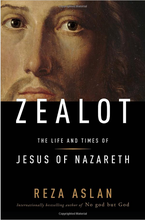
Since Aslan is a Muslim, some have responded to Zealot as if it is a Muslim look at Jesus. This is simply not the case; Zealot does not present traditional Muslim views of Jesus at all. Zealot is instead typical of other modern skeptical approaches to Jesus. Aslan is strongly influenced by (among others) John Dominic Crossan, the Jesus Seminar author who has written a number of books presenting Jesus as a peasant social revolutionary.
The central argument of Zealot is this: Jesus, like other messianic figures of his day, called for the violent expulsion of Rome from Israel. Driven by religious zeal, Jesus believed that God would empower him to become the king of Israel and overturn the hierarchical social order. Jesus believed that God would honor the zeal of his lightly armed disciples and give them victory. Instead, Jesus was crucified as a revolutionary. Early Christians changed the story of Jesus to make him into a peaceful shepherd. They did this for two reasons: because Jesus’ actual prediction had failed, and because the Roman destruction of rebellious Jerusalem in AD 70 made Jesus’ real teachings both dangerous and unpopular. Paul radically changed the identity of Jesus from human rebel to divine Son of God, against the wishes of other leaders like Peter and James.
To be fair to Aslan, there are several strengths to his book. He explains well the multifaceted economic, political and religious setting of first-century Palestine (with some exceptions pointed out below). While heavily influenced by Crossan, he abandons some of Crossan’s more bizarre claims. Interestingly, Aslan points out what strong eyewitness evidence there is for the resurrection, although ultimately he says that the resurrection is the sort of thing that historians simply cannot evaluate. He points out that Jesus’ contemporaries fully believed that Jesus performed healing miracles. Aslan also explains some things that most Christians are not aware of, but are widely accepted by both believing and non-believing scholars of the gospels. For example, Aslan correctly writes that Jews before Jesus were not expecting the messiah to be divine or for him to die and rise from the dead. He correctly explains the original significance of some of Jesus’ titles such as “Son of God” and “Son of Man,” both of which had kingly connotations before Jesus.
However, Zealot is seriously flawed in many ways. There are many factual errors (some of which I will highlight below), but more importantly, Aslan’s approach matches the flawed approach of Jesus Seminar scholars, which is almost guaranteed to produce a skewed picture of Jesus.
Zealot’s claim is essentially a conspiracy theory: Jesus was really a proclaimer of violent revolution, but the gospels and Paul covered up the evidence. Aslan then has a typical conspiracy-theory approach: any time the gospels present evidence against Aslan’s theory, they were making it up; any time the gospels present evidence in favor of Aslan’s theory, they were telling the truth. This is found countless times in Zealot, but a few examples will suffice.
Aslan is certain that Jesus never said “My kingdom is not of this world” (John 18:36), because of course that would be evidence against Aslan’s theory. The idea that Jesus was “an inveterate peacemaker” is a “complete fabrication” by the evangelists.1 Apparently, according to Aslan, Jesus never said “If anyone compels you to go one mile, go with him two” (Matt 5:41, talking about submission to soldiers who demand labor) or “Do not resist the one who is evil” (Matt 5:39). Although Aslan does not deny the historicity of Jesus’ parables, he dismisses them as impossible to understand - a claim that would surprise most modern scholars of the gospels. Aslan needs to dismiss the parables because the Kingdom of God described in the parables is mostly incompatible with violent revolution.
But Aslan is perfectly willing to accept the gospels’ testimony whenever it helps him. He accepts the historicity of sayings from Jesus such as “I have not come to bring peace, but a sword” (Matt 10:34) and “the kingdom of God suffers violence, and the violent take it by force” (Matt 11:12). Of course, Aslan ignores the clear context of those sayings, which has nothing to do with violent revolution. Aslan mostly dismisses the gospel accounts of Jesus’ arrest as entirely fictional, so he does not accept that Jesus stopped Peter from using a sword: “Put back your sword… For all who take up the sword will die by the sword” (Matt 26:51-52). But Aslan is quite willing to accept that Luke is correct when he records Jesus saying, earlier that evening, “Let the one who has no sword sell his cloak and buy one” (Luke 22:36). This pattern is repeated over and over in Zealot. It is simply an unfair and extremely biased treatment of the historical evidence. It presents Aslan as somehow having secret knowledge that allows him to correctly identify when the four evangelists were accurate and when they were fabricating. In reality, Aslan is simply ignoring most of the evidence against his theory.
The second big thrust of Zealot’s claim is that the peaceful, divine Jesus was made up primarily by Paul. According to Zealot, Peter and James sharply opposed Paul’s claim that Jesus was divine. The New Testament on several occasions does describe conflict: between Paul and Barnabas, between Paul and Peter, and between Paul and men from James. Aslan tries to pretend that all these arguments were about the identity of Jesus, and that Barnabas, Peter and James believed in Jesus as a human messiah against Paul’s view of a divine Christ. But this is simply nonsense. The disagreement between Paul and Barnabas is over the inclusion of Mark in their mission team, and Paul’s disagreement with James and Peter is over whether Gentiles need to keep Jewish laws such as circumcision and food laws.
Here again, Aslan is very selective in his use of evidence. He accepts the letter of James as being authorized by James, because it helps him emphasize (and exaggerate) differences between James and Paul. But he never even mentions the epistles of Peter, because of course they show that Peter is in agreement with Paul about who Jesus is. While pointing out the difference between James’ and Paul’s theology, Aslan doesn’t mention that James has an equally high view of Jesus: he is “our glorious Lord Jesus Christ” (James 2:1) who will return to judge (James 5:7). Aslan also ignores all of the evidence in the New Testament for agreement and harmony between the apostles, such as Paul's collection of money for poor Jewish Christians in Jerusalem.
Aslan’s conspiracy approach continues in this section of his book. Why does Paul make a sacrifice in Jerusalem? It must be that James forced him to recant his heretical views, not (as Luke claims) to complete a Nazirite vow that Paul voluntarily began before arriving in Jerusalem. Why does Luke end the book of Acts with Paul’s imprisonment, not his death? It must be to cover up some damning evidence against Paul! (No mention of the idea that Luke ended Acts then because that’s when he wrote Acts).
Perhaps not surprisingly, the claims in Zealot come with a fair degree of scholarly arrogance (which I acknowledge many scholars are prone to!). Aslan says that his goal is to “purge the scriptures of their literary and theological flourishes and forge a far more accurate picture of the Jesus of history… Everything else is a matter of faith.” In other words, when Aslan accepts some information from the gospels and rejects the rest, that is scholarly and historical; but if someone accepts other information from the gospels, their view is not scholarly or historical, but "a matter of faith." The parts of the gospels that Aslan agrees with are historical; the parts that he doesn’t agree with are “literary and theological flourishes.” Of course, Aslan often tries to explain why he thinks that some claim in the gospels is unhistorical, but taken as a whole, it is impossible to ignore the essential arbitrariness of his choices.
This scholarly hubris is also apparent in Zealot's determination to point out contradictions in the New Testament accounts. For example, Aslan wants to make sure that we know that Luke is mistaken when he says that the seven Hellenistic deacons (Acts 6) were primarily in charge of distributing food. They also engaged in preaching and evangelism, Aslan tells us. How does Aslan know that Luke is wrong? By reading the rest of Acts 6 and 7. In other words, Luke was not wrong – he just had more to say on the next page. Aslan is convinced that Pilate’s trial of Jesus is “a complete fabrication” by the evangelists, because Aslan is certain that he knows how Pilate thinks. Pilate, in Aslan’s telling, would have absolutely no problem sending someone to the cross without any trial at all. He bases this on a single line from the Jewish philosopher Philo, exaggerated out of proportion.
Finally, despite his generally good understanding of the field, Aslan makes a number of significant errors. I took pages of notes just on historical and linguistic errors in Zealot. Here are only a few examples of significant scholarly errors: use of Greek definitions not found in any standard Greek lexicon; using the wrong Greek lexicon for the New Testament; incorrect definition of the targumim; unawareness of the evidence for high literacy in ancient Israel; unawareness of literary approaches to the gospels; claims that violence against foreigners was the only faithful Jewish response; claims that Pilate crucified “thousands upon thousands” without trial; very late, unlikely dates for the writing of the four gospels; claims that ancient people did not understand the concept of history; claims that Luke was knowingly writing fiction, not history; claims that Mark does not describe Jesus’ resurrection; and on and on. In many cases, I had to come to the conclusion that Aslan was just not familiar enough with modern scholarship related to the New Testament.
There are numerous other problems with Zealot, too numerous to address in an already-too-long blog post. Aslan repeatedly presents highly unlikely interpretations of passages in the New Testament, makes little effort to defend those interpretations, then moves on as if he has made his case. Suffice to say this, as others have said before: there is something a little bizarre about using our only historical documents about Jesus (the New Testament) to come to conclusions quite in opposition to those documents. There is a good reason to believe that Jesus claimed to be a divine king and savior who would die and rise again, and would one day return to judge the world: all four gospels, and indeed the entire New Testament make this claim. You can deny that this claim is true, but it is scholarly folly to deny that the earliest Christians believed it.
 Biola University
Biola University

.jpg)

.jpg)